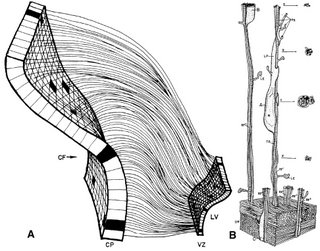|
Tuesday, October 03, 2006
Pasko Rakic (cited in the Lahn paper that JP just linked) has studied the role of programmed cell death (apoptosis) in determining the complexity of the mammalian neocortex. The neocortex is the outer shell of your brain, has a six-layered structure, and has ten times the surface area in humans compared to macaques. When brains get that much surface area they have to become convoluted and get all those gyri and fissures that make it look like a bowl of noodles. Mouse brains are, by contrast, smooth. However, when Rakic and colleagues knocked-out the caspase-3 and caspase-9 genes in mice (the former being identified as *hot* by Lahn) their brains got all noodly. There is obviously more to it than this however because the mice weren't supergeniuses. I think they died pretty quick actually.
This all relates back to Rakic's radial unit hypothesis of cortical development and evolution. During corticogenesis, cells that are destined to be neurons are produced by asymmetric division of radial glia cells. You might describe the fated neurons as budding off the radial glia mother cell. Radial glia are named thusly because they have long processes that radiate out from the neuronal birth area closer to the middle of the developing brain and attach to the outer areas where the neocortical cell layers will form. Like so:  When the neuron is born it grabs onto the radial glia and starts climbing. It climbs past previously born neurons, so the neocortex develops in an inside-out fashion. Neurons that climbed up the same radial glia end up as part of the same functional unit, perhaps even acting as one big electrical component, since they are more likely to be connected by gap-junctions. Rakic proposed that the size of the neocortex is determined by the number of radial units and thus the key developmental step for producing one of the most noticeable differences between humans and other primates will be radial glial proliferation. There are several factors that could affect the number of radial glia. I'll let him tell you what they are. Here is the free paper, skip to the last section: A comparative embryological analysis of telencephalic development led to the proposal of the radial unit hypothesis of the ontogenetic and phylogenetic expansion of the cerebral neocortex at the cellular level (Rakic, 1988). According to this hypothesis, the expansion of the surface of the cerebral cortex is accompanied not only by the proportional increase in the number and length of RG cells, but also by the earlier onset of their differentiation, as well as an increase in duration of the G1 phase of the cell cycle and their longevity during individual embryonic development (Kornack and Rakic, 1998). |



